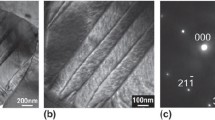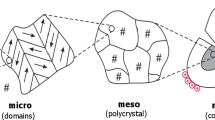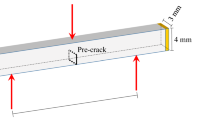Abstract
The agglomeration of point defects in ferroelectric ceramics could be driven by repeated domain switching under cyclic electric field. The evolution equation of pore concentration under cyclic electric field is derived, with the help of a relation between the pore concentration and the extent of pore agglomeration. The results of the simulation agree quantitatively with the experimental data. An integrated framework about the mechanisms of electrically induced fatigue is proposed, which links the mechanisms at different scales.
Similar content being viewed by others
References
Yang W. Mechatronic Reliability. Beijing-Berlin: Tsinghua University Press and Springer-Verlag, 2002
Nuffer J, Lupascu D C, Rödel J. Damage evolution in ferroelectric PZT induced by bipolar electric cycling. Acta Mater, 2000, 48: 3783–3794
Duiker H M, Beale P D, Scott J F, et al. Fatigue and switching in ferroelectric memories: Theory and experiment. J Appl Phys, 1990, 68: 5783–5791
Brennan C. Model of ferroelectric fatigue due to defect/domain interactions. Ferroelectrics, 1993, 150: 199–208
Hill M D, White G S, Huang C-S, et al. Cyclic damage in lead zirconate titanate. J Amer Ceramic Soc, 1996, 79: 1915–1920
Seelig T, Broedling N, Gross D. Modeling microstructural evolution by rearranging point defects in elastic media. Int J Eng Sci, 2004, 42: 339–351
Nuffer J, Lupascu D C, Glazounov A, et al. Microstructural modifications of ferroelectric lead zirconate titanate ceramics due to bipolar electric fatigue. J Eur Ceramic Soc, 2002, 22: 2133–2142
Geng L, Yang W. Agglomeration of point defects in ferroelectric ceramics under cyclic electric field. Modelling Simul Mater Sci Eng, 2006, 14: 137–155
Geng L, Yang W. Coalescence of pore columns by domain switching. Acta Mech Sin, 2006, 22: 207–216
Sihvola A H. Electromagnetic Mixing Formulas and Applications. London: Institution of Electrical Engineers, 1999
Suo Z. Motions of microscopic surfaces in materials. Adv Appl Mech, 1997, 33: 193–294
Suo Z, Lu W. Forces that drive nanoscale self-assembly on solid surfaces. J Nanoparticle Res, 2000, 2: 333–344
Herring C. Surface tension as a motivation for sintering. In: Kingston W E, ed. The Physics of Powder Metallurgy. New York: McGraw-Hill, 1951. 143–179
Mullins W W. Theory of thermal grooving. J Appl Phys, 1967, 28: 333–339
Suo Z, Lu W. Self-orgnazing nanophase on a solid surface. In: Chuang T-J, ed. Multi-scale Deformation and Fracture in Materials and Structures. A book dedicated to Professor James R. Rice on the occasion of his 60th birthday. Dordrecht: Kluwer Academic Publishers, 2000
Ni Y, He L H, Yin L. Three-dimensional phase field modeling of phase separation in stained alloys. Mater Chem Phys, 2000, 78: 442–447
Gruson A L. Continuum theory of ductile rupture by void nucleation and growth: Part I. Yield criteria and flow rules for porous ductile media. J Engng. Mater Technol, 1977, 99: 2–15
Tvergaard V, Needleman A. Analysis of the cup-cone fracture in a round tensile bar. Acta Metall, 1984, 32: 157–169
Koplik J, Needleman A. Void growth and coalescence in porous plastic solids. Int J Solids Structures, 1988, 24: 835–853
Zhu T, Fang F, Yang W. Fatigue crack growth in ferroelectric ceramics below coercive field. J Mater Sci Lett, 1999, 18: 1025–1027
Zhu T, Yang W. Fatigue crack growth in ferroelectrics under alternating electric loading. J Mech Phys of Solid, 1999, 47: 81–97
Author information
Authors and Affiliations
Corresponding author
Additional information
Supported by the National Natural Science Foundation of China (Grant Nos. 10332020 and 10121202) and the National “973” Project of China (Grant No. 2004CB619304)
Rights and permissions
About this article
Cite this article
Geng, L., Yang, W. Defect agglomeration in ferroelectric ceramics under cyclic electric field. Sci. China Ser. E-Technol. Sci. 51, 1296–1305 (2008). https://doi.org/10.1007/s11431-008-0148-z
Received:
Accepted:
Published:
Issue Date:
DOI: https://doi.org/10.1007/s11431-008-0148-z




